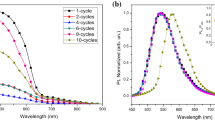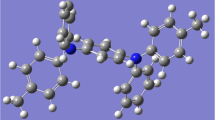Abstract
In this work, a set of thin films of ZnO nanoparticles doped with a conjugated oligomer {9,9,9′,9′,9″,9″-hexakis(hexyl)-2,7′;2′,7″-trifluorene} has been prepared. The optical and electrical measurements on pure oligomer, ZnO nanoparticles, and blended thin films have been investigated. The absorption spectra of the pure oligomer in thin films showed a single band at 350 nm. When the thickness was increased, there was no new band detected at the end of the spectrum. This is a strong indication that the oligomer cannot be present in the dimeric state. On the other hand, the photoluminescence (PL) spectra of the oligomer showed two distinguished peaks at 400 and 420 nm due to the monomer and excimer states, respectively. Furthermore, the results showed that the PL spectrum of the oligomer was affected by the thickness. For the blended thin films with different ratios of ZnO nanoparticles, the PL spectra showed an enhancement in intensity by increasing the concentration of ZnO nanoparticles. For the electrical properties, the addition of ZnO nanoparticles to oligomer had increased the current and luminescence. The luminescences of the pure and blend film at 10 V had reached 1000 and 4200 cd/m2, respectively; and the turn-on voltage was reduced from 10.5 to 5.8 V. The light emission in the device is due to the Auger-assisted energy up-conversion process. The lifetime of the blend’s diodes measured under standard atmospheric conditions was greatly improved.














Similar content being viewed by others
References
H. Shirakawa et al., Synthesis of electrically organic polymers:halogen derivatives of polyacetylene, (CH)X. J. Chem. Soc. Chem. Commun. 16, 578–580 (1977)
C.K. Chiang et al., Electrical conductivity in doped polyacetylene. Phys. Rev. Lett. 39(17), 1098–1101 (1977)
C.K. Chiang et al., Synthesis of highly conducting films of derivatives of polyacetylene, (CH)x. J. Am. Chem. Soc. 100(3), 1013–1015 (1978)
A. Facchetti, Π-Conjugated polymers for organic electronics and photovoltaic cell applications. Chem. Mater. 23(3), 733–758 (2010)
X. Guo, M. Baumgarten, K. Müllen, Designing π-conjugated polymers for organic electronics. Prog. Polym. Sci. 38(12), 1832–1908 (2013)
T. Mikie, I. Osaka, Small-bandgap quinoid-based π-conjugated polymers. J. Mater. Chem. C (2020). https://doi.org/10.1039/D0TC01041C
H. Sirringhaus et al., Two-dimensional charge transport in self-organized. High-Mobil. Conj. Polym. Nat. 401(6754), 685–688 (1999)
J.H. Burroughes et al., Light-emitting diodes based on conjugated polymers. Nature 348(6299), 539–541 (1990)
J.J.M. Halls et al., Photodiodes based on polyfluorene composites: influence of morphology. Adv. Mater. 12(7), 498–502 (2000)
J. Chappell et al., Correlating structure with fluorescence emission in phase-separated conjugated-polymer blends. Nat. Mater. 2(9), 616–621 (2003)
P.H. Wang et al., Synthesis of thermal-stable and Photo-crosslinkable polyfluorenes for the applications of polymer light-emitting diodes. J. Polym. Sci., Part A: Polym. Chem. 48(3), 516–524 (2010)
Z. Liu, C. Lin et al., Micro-light-emitting diodes with quantum dots in display technology. Light Sci. Appl. 9(1), 83 (2020)
M. Zubair et al., Improvement of solution based conjugate polymer organic light emitting diode by ZnO–graphene quantum dots. J. Mater. Sci.: Mater. Electron. 26(5), 3344–3351 (2015)
E. Taeshik, A. Eilaf, A.J. Samson, Solution-processed highly efficient blue phosphorescent polymer light-emitting diodes enabled by a new electron transport material. Adv. Mater. 22(42), 4744–4748 (2010)
D. Abbaszadeh et al., Efficient polymer light-emitting diode with air-stable aluminum cathode. J. Appl. Phys. 119(9), 095503 (2016)
H. Sirringhaus, Device physics of solution-processed organic field-effect transistors. Adv. Mater. 17(20), 2411–2425 (2005)
D.J. Gundlach et al., High mobility n-channel organic thin-film transistors and complementary inverters. J. Appl. Phys. 98(6), 59400O (2005)
O. Inganäs et al., Recent progress in thin film organic photodiodes. Synth. Met. 121(1–3), 1525–1528 (2001)
R.J. Mortimer, Organic electrochromic materials. Electrochim. Acta 44(18), 2971–2981 (1999)
G. Yu et al., Polymer photovoltaic cells-enhanced efficiencies via a network of internal donor-acceptor heterojunctions. Science 270(5243), 1789–1791 (1995)
P. Panda et al., Charge transfer absorption for π-conjugated polymers and oligomers mixed with electron acceptors. J. Phys. Chem. B 111(19), 5076–5081 (2007)
S. Barth et al., Photogeneration and recombination of charge carriers in LEDs: related organic materials. Proc. R. Soc. A 355(1725), 749–761 (1997)
S.S. Sharma, K. Sharma, G.D. Sharma, Efficient bulk heterojunction photovoltaic devices based on modified PCBM. Nanotechnol. Rev. 4(5), 419–428 (2015)
J.S. Shankar et al., Studies on optical characteristics of multicolor emitting MEH-PPV/ZnO hybrid nanocomposite. J. Polym.-Plast. Technol. Mater. 58(2), 148–187 (2019)
A.A. Argun, A. Cirpan, J.R. Reynolds, The first truly all-polymer electrochromic devices. Adv. Mater. 15(16), 1338–1341 (2003)
A.N. Aleshin, S.R. Williams, A.J. Heeger, Transport properties of poly(3,4-ethylenedioxythiophene)/poly(styrenesulfonate). Synth. Met. 94(2), 173–177 (1998)
C. Soci et al., Photoconductivity of a low-bandgap conjugated polymer. Adv. Funct. Mater. 17(4), 632–636 (2007)
N.T. Kemp et al., Thermoelectric power and conductivity of different types of polypyrrole. J. Polym. Sci. B: Polym. Phys. 37(9), 953–960 (1999)
J. Cornil et al., Electronic and optical properties of polyfluorene and fluorene-based copolymers: a quantum-chemical characterization. J. Chem. Phys. 118(14), 6615 (2003)
Q. Pei, Y. Yang, Efficient photoluminescence and electroluminescence from a soluble polyfluorene. J. Am. Chem. Soc. 118(31), 7416 (1996)
Y. Ohmori et al., Blue electroluminescent diodes utilizing poly(alkylfluorene). Jpn. J. Appl. Phys. 30(11B), L1941 (1991)
H.H. Lu et al., Excimer formation by electric field induction and side chain motion assistance in polyfluorenes. Macromolecules 38(26), 10829–10835 (2005)
A.M. Assaka et al., Novel fluorine containing polyfluorenes with efficient blue electroluminescence. Polymer 45(21), 7071–7081 (2004)
M. Vachaa, J. Hab, H. Sato, On the origin of excimer emission in electroluminescence and photoluminescence spectra of polyfluorenes. J. Lumin. 122(1), 620–622 (2007)
R.H. Friend et al., Electroluminescence in conjugated polymers. Nature 397(6715), 121–128 (1999)
M.T. Bernius, M. Inbasakaran, J. O’Brien, W. Wu, Progress with light-emitting polymers. Adv. Mater. 12(23), 1737 (2000)
M. Leclerc, Polyfluorenes: twenty years of progress. J. Polym. Sci. A: Polym. Chem. 39(17), 2867–2873 (2001)
U. Scherf, E. List, Semiconducting polyfluorenes-towards reliable structure-property relationships. Adv. Mater. 14(7), 477–487 (2002)
N.H.A. Rahman et al., Electroluminescence behavior of MEH-PPV based organic light emitting diode, in RSM2013 Proceedings, 2013, Langkawi, Malaysia, pp. 265–268
A. Alyamani et al., Spectral, electrical and morphological properties of spin coated MEH-PPV and cresyl violet blended thin films for a light emitting diode. Optik 127(4), 2331–2335 (2016)
L. Yanwei et al., Highly efficient, solution-processed organic light-emitting diodes based on thermally activated delayed-fluorescence emitter with a mixed polymer interlayer. ACS Appl. Energy Mater. 1(2), 543–551 (2018)
J. Yang et al., High-efficiency saturated red emitting polymers derived from fluorene and naphthoselenadiazole. Macromolecules 37(4), 1211–1218 (2004)
ChP Kuo et al., Tunable electrofluorochromic device from electrochemically controlled complementary fluorescent conjugated polymer films. ACS Appl. Mater. Interfaces. 6(20), 17402–17409 (2014)
H. Qiong et al., Synthesis and electroluminescent properties of high-efficiency saturated red emitter based on copolymers from fluorene and 4, 7-di (4-hexylthien-2-yl)-2,1,3-benzothiadiazole. Macromolecules 37(17), 6299–6305 (2004)
R. Tian, Y. Mo, J. Peng, Efficient polymer light-emitting diodes with violet blue emission based on blends of PSiF6-PPP and PSiFC6C6. Chin. Sci. Bull. 51(8), 2805–2808 (2006)
T. Virgili et al., Deep blue light amplification from a novel triphenylamine functionalized fluorene thin film. Molecules 25(1), 1–11 (2019)
N. Mustapha, Z. Fekkai, K. Ibnaouf, Improved performance of organic light—emitting diodes based on oligomer thin films with graphene. J. Electron. Mater. 49(2B), 1–8 (2020)
N. Mustapha, Z. Fekkai, A. Alkaoud, Enhanced efficiency of organic solar cells based on (MEH-PPV) with graphene and quantum dots. Optik 127(5), 2755–2760 (2015)
K.W. Jeong et al., Enhancing the electroluminescence of OLEDs by using ZnO nanoparticle electron transport layers that exhibit the Auger electron effect. Mol. Cryst. Liq. Cryst. 663(1), 61–70 (2018)
N. Mustapha, M.S. AlSalhi, S. Prasad, Energy transfer-enhanced external power conversion efficiency in blended polymeric thin film solar devices. J. Mater. Sci.: Mater. Electron. 30(8), 7840–7849 (2019)
N.K. Cuong, N.Q. Khanh, Photoluminescence and I–V characteristics of blended conjugated polymers/ZnO nanoparticles. VNU J. Sci.: Math. Phys. 32(1), 52–60 (2016)
I. Musa et al., Investigations of optical properties of MEH-PPV/ZnO nanocomposites by photoluminescence spectroscopy. Synth. Met. 162(s 19-20), 1756–1761 (2012)
M.V.M. Rao et al., J. Electrochem. Soc. 157(8), H832–H836 (2010)
M. Dahnoun et al., Structural, optical and electrical properties of zinc oxide thin films deposited by sol-gel spin coating technique. Optik 134, 53–59 (2017)
G.K. Williamson, W.H. Hall, X-ray line broadening from filed aluminium and wolfram. Acta Met. 1, 23 (1953)
N.V. Konoshchuk, L.N. Grebinskaya, V.D. Pokhodenko, Effect of the method of production of the inorganic matrix on the spectral characteristics of hybrid ZnO/MEH-PPV nanocomposites. Theor. Exp. Chem. 44(6), 339–344 (2008)
H. Geng et al., A facile route for preparation of conjugated polymer functionalized inorganic semiconductors and direct application in hybrid photovoltaic devices. Sol. Energy Mater. Sol. Cells 94(7), 1293–1299 (2010)
L. Qian et al., Electroluminescence from light-emitting polymer/ZnO nanoparticle heterojunctions at sub-bandgap voltages. Nano Today 5(5), 384–389 (2010)
Acknowledgements
The authors would like to thank Imam Mohammad Ibn Saud Islamic University for the partial financial support of this project under contract number (341201).
Author information
Authors and Affiliations
Corresponding author
Ethics declarations
Conflict of interest
The authors declare that there is no conflict of interest regarding the publication of this paper.
Additional information
Publisher's Note
Springer Nature remains neutral with regard to jurisdictional claims in published maps and institutional affiliations.
Rights and permissions
About this article
Cite this article
Mustapha, N., Rafea, M.A., Aldaghri, O. et al. Influence of ZnO nanoparticles on the performance of LED based on oligomer thin films. J Mater Sci: Mater Electron 32, 5473–5481 (2021). https://doi.org/10.1007/s10854-021-05269-y
Received:
Accepted:
Published:
Issue Date:
DOI: https://doi.org/10.1007/s10854-021-05269-y




